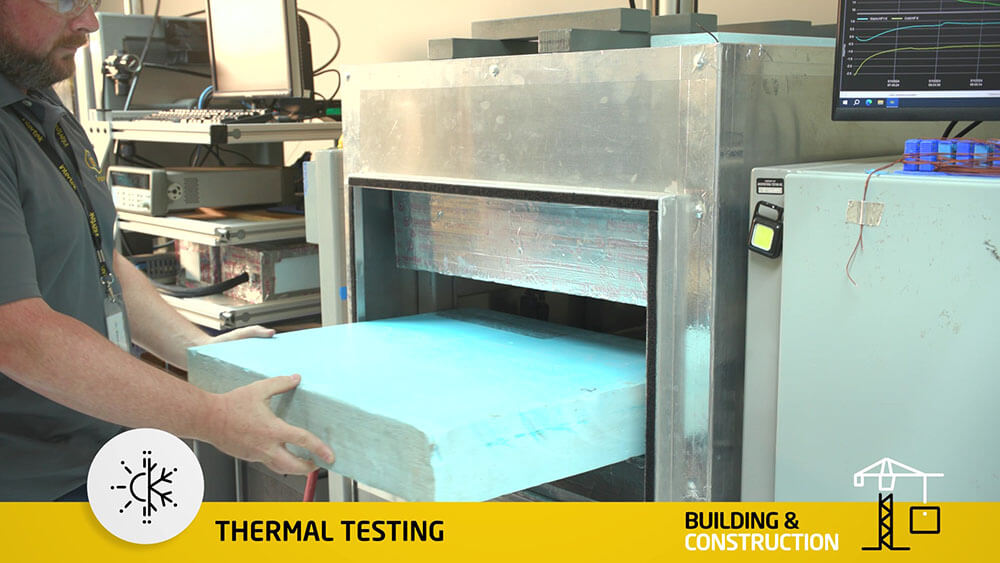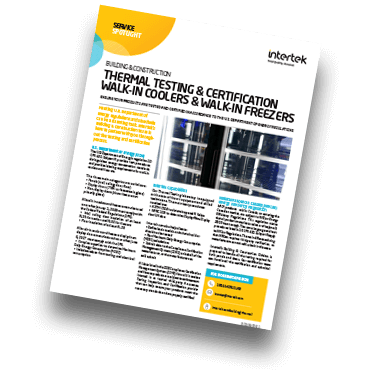Regulate the energy performance of your building materials, products, and systems with precision thermal conductivity and resistance testing and NFRC Product Certification solutions
What is Thermal Conductivity Testing?
Thermal conductivity testing measures how effectively a material conducts heat, providing critical data for product design, quality control, and regulatory compliance. This property is essential for applications where heat transfer impacts safety, performance, or efficiency—such as electronics, insulation materials, and automotive components.
Why is Thermal Conductivity Testing Important?
Thermal conductivity and resistance testing is essential for building products because it directly affects energy efficiency, occupant comfort, and code compliance. Testing determines how well a material conducts heat, which helps manufacturers and designers understand how products will perform in real-world thermal environments.
Materials with low thermal conductivity—such as insulation, foams, and wall systems—are designed to reduce heat transfer, helping maintain stable indoor temperatures and lower energy costs. Conversely, materials with high thermal conductivity, like metals or stone, are used strategically where heat dissipation or structural performance is required.
Accurate thermal conductivity data is also critical for meeting building codes and standards, such as ASHRAE, ASTM, and ISO energy performance requirements. It allows manufacturers to quantify R-values and U-factors, validate marketing claims, and demonstrate compliance with energy efficiency programs such as LEED, ENERGY STAR, or regional regulations.

Intertek's Thermal Testing
How is Thermal Performance measured?
Thermal Transmission (U-Factor)
Determine the rate of heat transfer through your product or system.
Thermal Resistance (R-Factor)
Understand your product or system’s resistance to heat transfer.
Thermal Conductivity (k-Value)
Obtain data on the transmission of heat through your material.
Solar Heat Gain Coefficient (SHGC)
Measure the transmission of the sun’s heat through your material, product or system.
Visible Transmittance (VT or VTL)
Detect the level of transmission of the sun’s light through your material, product or system.
Condensation Resistance (CRF)
Test your system for the potential occurrence of condensation on the interior.
Temperature Cycling
Subject your product to accelerated weathering/ageing or extreme conditions.
Intertek's Thermal Conductivity and Resistance Testing Solutions
Obtain Energy Star Compliance, NFRC Certification, or meet any local or federal energy code by utilizing the lab with the industry’s most expansive thermal testing and thermal simulations services and most advanced thermal testing chambers.
With our comprehensive capabilities, we can provide technical reports for performance thermal testing and thermal simulations of materials or components, data collection and statistical analysis, and authoritative advice on general principles that may be affecting your results.
NFRC Product Certification
The National Fenestration Rating Council (NFRC) Product Certification Program was developed to create a standardized procedure for rating the performance of windows, doors, and skylights. Prior to the development of the NFRC program, there was no single standardized procedure for rating products which created confusion, resulted in inconsistencies, and made it impossible to directly compare products. Obtaining NFRC product certification results in a rating, a program label for customer verification, and entry in the NFRC Certified Product Directory.
NFRC requires certification by an accredited third-party agency. The Inspection Agency of the manufacturer’s choosing reviews the submitted computer simulations and physical test reports to confirm product compliance. Once compliance is verified, the Inspection Agency issues the certification. In addition, the third-party agency selected will conduct yearly plant audits to ensure on-going compliance.
Computer Simulations & Physical Testing
Computer simulations and U-Factor physical testing must be completed in order to obtain NFRC certification. The U-Factor physical test is conducted to validate the results produced by the computer simulation. This process ensures the product is being fabricated as indicated in the drawings. Air leakage physical testing is optional for NFRC certification but could be required for compliance with local codes or to obtain Energy Star certification.
There is no specific order required for the computer simulations and physical testing to be performed in. If expectations for the product performance are unclear, it is recommended that the simulations are completed first, thus allowing any necessary design modifications to be completed prior to the fabrication of the physical test units.
Products that benefit from Thermal Testing
Test Equipment
Guarded Hot Box (GHB)
Solar Calorimeter (SOL)
Large Diameter Integrating Sphere (LDIS)
Environmental Chambers (EC)
Heat Flow Meters (HFM)
Computer Simulation Software (W6 / T6)
Knowledge Center
Building Health & Wellness: An Overview of Services
Acoustical Testing & Consulting Resources
Remote Pre Inspections for NFPA 80 / 101
Protek - Safety. Everywhere. Every Day
Fire Doors 101: Your Guide to Testing and Certification - Webinar Recording
Tornado Testing & Certification Requirements - Webinar Recording
Plumbing Products Testing & Certification - Webinar Recording
The Evolving Code Evaluation Process White Paper
Proposition 65 & the Furniture Industry Webinar Recording
Why Planning for FCC Certification is Key to Success in the Door Hardware Industry White Paper

Upcoming Tradeshows & Events
Resources
- Search and Buy Building & Construction Standards
- SpecDirect
- Building Products Directory
- Project Connect (formerly myATI) – B&C Products
- Construction Hive – B&C Projects (PSIQest)
- My TestCentral

